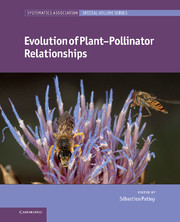Book contents
- Frontmatter
- Contents
- Contributors
- Preface
- 1 Macroevolution for plant reproductive biologists
- 2 Pollination crisis, plant sex systems, and predicting evolutionary trends in attractiveness
- 3 Evolution and ecological implications of “specialized” pollinator rewards
- 4 Fig–fig wasp mutualism: the fall of the strict cospeciation paradigm?
- 5 Fossil bees and their plant associates
- 6 Pollen evidence for the pollination biology of early flowering plants
- 7 Pollinator mediated floral divergence in the absence of pollinator shifts
- 8 Animal pollination and speciation in plants: general mechanisms and examples from the orchids
- 9 Why are floral signals complex? An outline of functional hypotheses
- 10 A survey on pollination modes in cacti and a potential key innovation
- 11 Zygomorphy, area, and the latitudinal biodiversity gradient in angiosperms
- 12 Ambophily and “super generalism” in Ceratonia siliqua (Fabaceae) pollination
- 13 Structure and dynamics of pollination networks: the past, present, and future
- 14 Pollinators as drivers of plant distribution and assemblage into communities
- 15 Effects of alien species on plant–pollinator interactions: how can native plants adapt to changing pollination regimes?
- 16 Pollen resources of non-Apis bees in southern Africa
- 17 Advances in the study of the evolution of plant–pollinator relationships
- Index
- Plate section
- References
17 - Advances in the study of the evolution of plant–pollinator relationships
Published online by Cambridge University Press: 05 January 2012
- Frontmatter
- Contents
- Contributors
- Preface
- 1 Macroevolution for plant reproductive biologists
- 2 Pollination crisis, plant sex systems, and predicting evolutionary trends in attractiveness
- 3 Evolution and ecological implications of “specialized” pollinator rewards
- 4 Fig–fig wasp mutualism: the fall of the strict cospeciation paradigm?
- 5 Fossil bees and their plant associates
- 6 Pollen evidence for the pollination biology of early flowering plants
- 7 Pollinator mediated floral divergence in the absence of pollinator shifts
- 8 Animal pollination and speciation in plants: general mechanisms and examples from the orchids
- 9 Why are floral signals complex? An outline of functional hypotheses
- 10 A survey on pollination modes in cacti and a potential key innovation
- 11 Zygomorphy, area, and the latitudinal biodiversity gradient in angiosperms
- 12 Ambophily and “super generalism” in Ceratonia siliqua (Fabaceae) pollination
- 13 Structure and dynamics of pollination networks: the past, present, and future
- 14 Pollinators as drivers of plant distribution and assemblage into communities
- 15 Effects of alien species on plant–pollinator interactions: how can native plants adapt to changing pollination regimes?
- 16 Pollen resources of non-Apis bees in southern Africa
- 17 Advances in the study of the evolution of plant–pollinator relationships
- Index
- Plate section
- References
Summary
Introduction
The scheme behind the present book was to draw the big picture of pollination, gathering contributions from the different domains within biology. Throughout, authors have examined many different types of data to address questions of an evolutionary flavor. Authors have not only considered the evolution of the interacting plants and pollinators, and the complexity of the adaptations shown by one and the other, but they also have discussed the complexity of the relationships between these forms of life, as well as what can be ascertained of the evolution of these relationships through time. The chapters were organized into a series of main topics, according to which the present conclusions are also structured.
Phylogenies of plants and pollinators are the natural backbone upon which several of the chapters were written, and evolutionary theory defines the framework in which various types of data on pollination relationships were presented and discussed. Phylogenetics and evolutionary theory were used or at least conceptualized by a number of contributing authors. Chapters such as the ones by Michez et al. (Chapter 5) and Hu et al. (Chapter 6) for example, take their complete sense from studies using their results, parallel with phylogenetic approaches, to shed light on pollinator evolution. Opening the present volume, Paul Wilson dedicated his remarkable chapter (Chapter 1) to how fundamental components of the evolutionary process should be applied hierarchically to micro- and macroscales, where the macroscale is a phylogenetic one. A series of other contributions focus on other aspects of evolution in plant–pollinator systems.
- Type
- Chapter
- Information
- Evolution of Plant-Pollinator Relationships , pp. 458 - 468Publisher: Cambridge University PressPrint publication year: 2011



